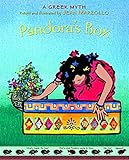Lesson 3: Gods and Goddesses
Lesson Plan
Pandora's Box | 480L

- Learning Goal
- Identify gods and goddesses in a myth.
- Explain that myths often have ancient gods and goddesses as characters.
- Duration
- Approximately 50 minutes
- Necessary Materials
- Provided: Unit Example Chart, Independent Practice Worksheet
Not Provided: Little Bear, You’re a Star! retold by Jean Marzollo and Pandora’s Box retold by Jean Marzollo, chart paper, markers
-
Teacher Modeling

will explain that another characteristic of myths is that they often have gods and goddesses. I will add this to my Characteristics of Myths Chart. (Example Chart is provided in Unit Teacher and Student Materials.) Gods and goddesses are powerful beings that are not human. They often create or control things on Earth. Many myths were first told when people believed in many different gods. I will identify 1-2 examples of gods and goddesses in the familiar myth Little Bear, You’re a Star! (From Lesson 1). I will do this by looking for characters that are explicitly called gods or goddesses in the text or by identifying characters that have powers that humans do not have in the story. For example, on the first page, the author mentions Zeus and Hera. I will record the title and examples on my chart.
-
Think Check
Ask: "How did I identify gods and goddesses in the myth?" Students should explain that you looked for characters that are described as gods and goddesses or have powers that humans do not have in the story.
-
Guided Practice

will read the myth, Pandora’s Box and work together to identify gods and goddesses in the myth. We will discuss how gods and goddesses are powerful and different from the humans in the story. For example, we will identify the Greek gods Zeus and Hermes. We will explain that one reason we know we are reading a myth is because the story has gods and goddesses.
-
Independent Practice

will identify and illustrate one god or goddess in Pandora’s Box (Independent Practice Worksheet is provided). You will present your god or goddess, describe who they are in the story, and use this to explain how you know this is a myth.
Texts & Materials
Standards Alignment
(To see all of the ReadWorks lessons aligned to your standards, click here.)


